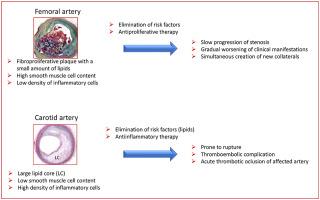Atherosclerosis ( IF 4.9 ) Pub Date : 2021-09-11 , DOI: 10.1016/j.atherosclerosis.2021.09.012 Pavel Poredoš 1 , Matija Cevc 1 , Aleš Blinc 2

|
Atherosclerosis is a systemic disease with different faces. Despite identical or similar pathogenetic mechanisms, atherosclerotic lesions and their clinical manifestations vary in different parts of the vascular system. Peripheral arterial disease (PAD) represents one of the most frequent clinical manifestations of atherosclerosis with predominant location in the superficial femoral artery (SFA). Morphological characteristics of atherosclerotic plaques in peripheral arteries differ from lesions in the coronary and carotid arteries. Plaques in SFA have more fibrotic components, less lipids and inflammatory cells, which makes them more stable and less prone to rupture. Factors that determine the different structure of plaques in SFA compared to coronary arteries include hemodynamic forces, vasa vasorum and calcification. Low shear stress in SFA in the adductor canal is one of the factors which determines frequent atherosclerotic lesions in this region. Lower lipid content and fewer inflammatory cells explain higher stability of SFA plaques. The specific structure of SFA plaques may require preventive and therapeutic measures, which to some extent differ from prevention of coronary atherosclerosis and may include inhibition of fibrotic proliferation in SFA plaques and calcification. Revascularization of PAD differs from procedures used in coronary arteries and requires specific technical expertise and devices.
中文翻译:

股腘动脉粥样硬化特征及其临床意义
动脉粥样硬化是一种具有不同面貌的全身性疾病。尽管发病机制相同或相似,但动脉粥样硬化病变及其临床表现在血管系统的不同部位有所不同。外周动脉疾病 (PAD) 是动脉粥样硬化最常见的临床表现之一,主要位于股浅动脉 (SFA)。外周动脉中动脉粥样硬化斑块的形态特征不同于冠状动脉和颈动脉中的病变。SFA 中的斑块具有更多的纤维化成分、更少的脂质和炎症细胞,这使得它们更稳定且不易破裂。与冠状动脉相比,决定 SFA 斑块结构不同的因素包括血流动力学力、血管滋养管和钙化。内收管内 SFA 的低剪切应力是决定该区域动脉粥样硬化病变频繁的因素之一。较低的脂质含量和较少的炎症细胞解释了 SFA 斑块的较高稳定性。SFA 斑块的特定结构可能需要预防和治疗措施,这在某种程度上不同于预防冠状动脉粥样硬化,可能包括抑制 SFA 斑块中的纤维化增殖和钙化。PAD 的血运重建不同于冠状动脉中使用的程序,需要特定的技术专长和设备。SFA 斑块的特定结构可能需要预防和治疗措施,这在某种程度上不同于预防冠状动脉粥样硬化,可能包括抑制 SFA 斑块中的纤维化增殖和钙化。PAD 的血运重建不同于冠状动脉中使用的手术,需要特定的技术专长和设备。SFA 斑块的特定结构可能需要预防和治疗措施,这在某种程度上不同于预防冠状动脉粥样硬化,可能包括抑制 SFA 斑块中的纤维化增殖和钙化。PAD 的血运重建不同于冠状动脉中使用的程序,需要特定的技术专长和设备。











































 京公网安备 11010802027423号
京公网安备 11010802027423号